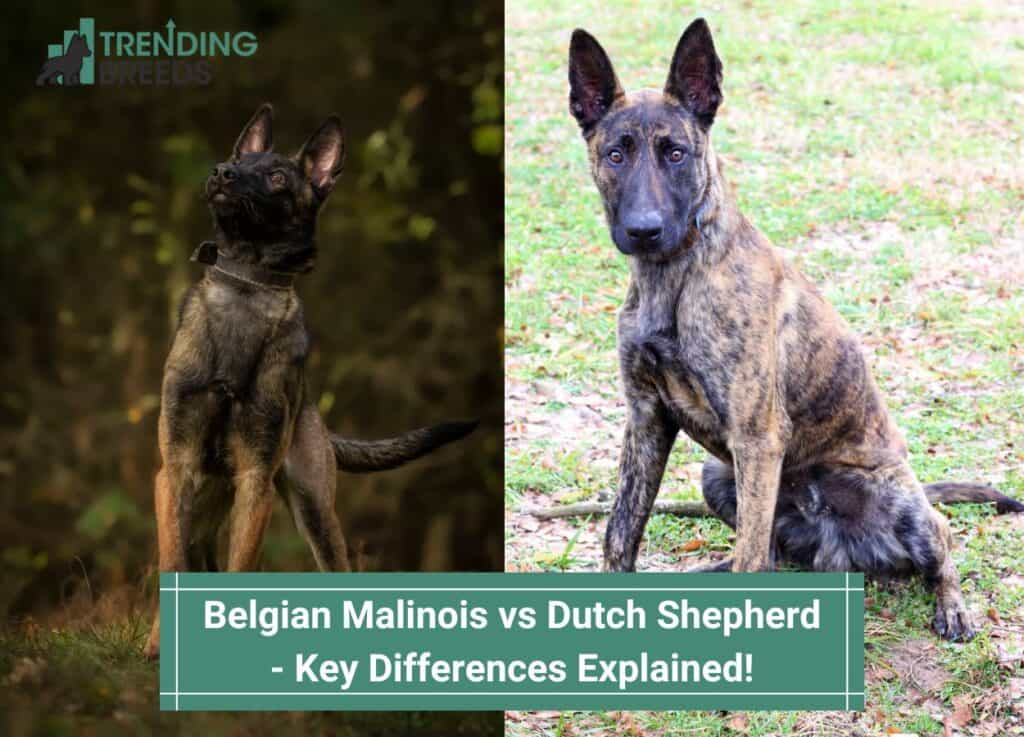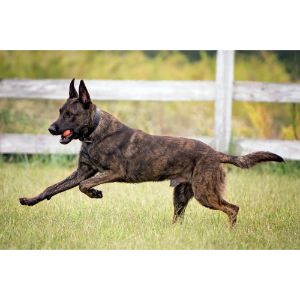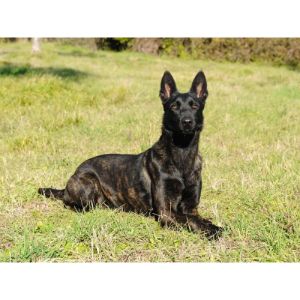
The Belgian Malinois and Dutch Shepherd dogs are both big, bold, and brave dogs that make excellent companions for the right people.
If you’re wondering which one you would be better suited to, let’s take a look at the similarities and differences between Belgian Malinois and Dutch Shepherds to help you decide.
Other articles you would like: How Rare Is A Brindle Belgian Malinois? and Do Long Hair Belgian Malinois Exist?
Table of Contents
Dutch Shepherd vs Belgian Malinois

Here is how they compare.
History
The Belgian Malinois was bred to herd sheep and were bred from common herding dogs from Western Europe, such as the Dutch Shepherd and the German Shepherd. They were first bred in the 19th century and almost went extinct at the end of the century.
The Dutch Shepherd, on the other hand, was discovered as a naturally occurring shepherd’s dog type living in the rural parts of the Low Lands in the Netherlands. They, too, almost went extinct in the early 20th century.
Varieties
Both the Belgian Malinois and Dutch Shepherd come in a few different varieties. The Belgian Malinois comes in four variations, which are determined by coat type and color.
Malinois (fawn-mahogany colored short coat with black mask), the Tervuren (fawn-mahogany colored long coat with black mask), the Laekenois (fawn colored rough coat), and the Groenendael (black colored long coat).
The Dutch Shepherd, on the other hand, comes in three varieties; long-haired (long, straight, flat, and harsh fur), short-haired (quite hard and short fur), and wire-haired (medium-length coat with dense, harsh, and tousled fur).
Size
Both breeds are large dogs. The average height of a Dutch Shepherd is between 21-24 inches or 55-62 cm depending on their sex, and they weigh between 66-88 lbs or 30-40 kgs depending on their size.
The Belgian Malinois is of a similar size, standing at 22-26 inches or 56-66 cm tall, and weighing between 44-66 lbs or 20-30 kgs.
Appearance
One of the biggest similarities between Belgian Malinois and Dutch Shepherd dogs is how they look. They are both big breeds with broad, muscular builds and big heads with long muzzles and pointed triangular ears.
Coat

As mentioned above, Dutch Shepherds and Belgian Malinois both come in different varieties; Dutch Shepherds can be short-coated, long-coated, or wire-coated, whilst Belgian Malinois dogs can be short-coated, long-coated, or rough-coated.
Both breeds have a dense insulating undercoat, regardless of their coat type. Their coats are thick and, unless rough or wiry, they have straight fur that is usually coarse to the touch.
Shedding
Both dogs shed moderately all year round, but they shed particularly heavily during the so-called “shedding seasons”, or in the 2-4 week transition from spring to summer and fall to winter.
In which they shed their old seasonal coat to make way for a new seasonally appropriate one.
Are they hypoallergenic?
Neither breed is classed as a hypoallergenic dog because they both shed a significant amount of hair and would definitely trigger symptoms in anyone with allergies to pet hair.
However, there are things you can do to reduce their shedding if you’re desperate to own one, such as using de-shedding supplements and shampoos, but you can’t stop them from shedding altogether.
Color
Another similarity between the breeds is their variety of coat colors. According to the American Kennel Club, the Belgian Malinois comes in several colors.
Including fawn, fawn sable, mahogany, red, brindle, cream, grey, liver, mahogany, black, and red sable, whilst the Dutch Shepherd can be brindle, gold brindle, grey brindle, salt and pepper, silver brindle, and blue grey.
Markings
Belgian Malinois dogs typically have black ears and a black mask on the face. Occasionally, they also have white markings on the toes or a small white mark on the chest.
Dutch Shepherds don’t typically have markings, but some of them do have some small white markings on the toes, stomach, chest, and muzzle.
Temperament
Both of these breeds are alert, active, and athletic, as well as intelligent, loyal, brave, and protective.
The Belgian Malinois in particular is very hard-working, so they tend to be more vocal and protective than the Dutch Shepherd, and the Dutch Shepherd tends to be slightly more playful.
Both dogs need lots of socialization from an early age to avoid territorial behaviors toward other dogs and strangers, but they are always loving with family.
Children

Any dog can be good with children when they’re raised with them from an early age, but Dutch Shepherds tend to be better suited to life with children than the Belgian Malinois, which can be a little bit boisterous for small children.
Working
Dutch Shepherds have multiple talents and can be put to work in several roles and competitions including agility, guard work, search and rescue, herding, field training, police work, and guide dog duty.
Belgian Malinois can also work as police and military dogs, as well as protection dogs.
Training
Although both of these breeds are highly intelligent and trainable, they’re also independent thinkers and can be stubborn because of it.
So, owners need to be consistent and firm in their training sessions, which should be short and sweet with lots of positive reinforcement.
Obedience, impulse control, and socialization should be the main priority for these dogs. You can practice obedience training with recall and basic tricks like sit and stay, and impulse control by getting your dog to wait for treats and food.
Socialization should be done by introducing your dog to new people and other dogs from a very young age in a safe, supervised environment like at home and on group walks, with all good behavior and experiences being praised and rewarded.
Diet
The Belgian Malinois and the Dutch Shepherd should both eat nutritiously complete and balanced age-appropriate food for large breeds that contain natural ingredients with all of the key nutrients they need to support whole body health.
Such as vitamins like A, B, C, E, and K for healthy organs and minerals like magnesium and calcium for bone, muscle, cognitive, and cellular health.
They also need lean protein sources like chicken and lamb for strong muscles, healthy carbohydrates like rice to power their active lives, and antioxidants from fruits and veggies for preventative health.
As well as healthy fats like Omega fatty acids, to nourish their coats and joints. Both dogs need 2-3 cups of food per day as adults, split into two equally spaced-out meals.
Exercise
Belgian Malinois dogs and Dutch Shepherds both need at least an hour of exercise per day, but preferably closer to two, and ideally split between two or three walks.
It’s a good idea to vary the location of your walks to prevent them from getting bored; both dogs are known to enjoy walking, running, hiking, camping, and swimming.
Grooming

Dutch Shepherds and Belgian Malinois with short and long coats both need a similar amount of grooming. They need to be brushed at least once a week with a firm slicker brush and bathed once every few months with a natural dog shampoo.
Dogs with wiry or rough coats, however, should be brushed and bathed slightly more often. They should be brushed at least twice a week and bathed once every month or two, depending on their activity level.
Mental stimulation
Mental stimulation is just as important as physical exercise for both of these breeds. They are both shepherd breeds, and shepherd breeds tend to get bored very easily, which can lead to anxiety and destructive behaviors.
To avoid this, you should engage in mentally stimulating play with these dogs every day with fun and challenging games, such as hide and seek, treasure hunt, and the cup game, as well as interactive toys like puzzles, snuffle mats, sensory toys, and treat dispensers.
Health & lifespan
The Dutch Shepherd has an average lifespan of 11-14 years, whilst the Belgian Malinois has a slightly longer one at 14-16 years.
They’re both generally healthy dogs but every breed or crossbreed is naturally predisposed to experiencing certain health conditions. For the Dutch Shepherd, this includes:
- Allergies
- Masticatory myositis
- Pannus
- Cryptorchidism
- Inflammatory bowel disease
- Goniodysplasia (rough-haired variety)
Common conditions that affect Belgian Malinois include:
- Hip and elbow dysplasia
- Progressive retinal atrophy
- Cataracts
- Pannus
- Hemangiosarcoma.
Owners should familiarise themselves with the signs and symptoms of these issues and seek veterinary attention if their dog’s body or behavior changes.
Some of the conditions are more severe than others, so it’s important to only buy puppies from reputable breeders that provide signed guarantees of good health.
Cost
The average cost of a Belgian Malinois in the United States is currently between $800-$1800, while the average price of a Dutch Shepherd is around $1000-$2,500, and shelter dogs can vary from $100-$600, depending on the shelter.
There are a few factors that can determine the cost of a puppy; including the breeder, coat color, and lineage. Established and high-quality breeders tend to be more costly, but worth it for the high quality of care.
Pups with rare and popular or favored coat colors also tend to be more expensive, as well as pups from working and show lines.
Similarly sized dogs tend to cost the same sort of money – and the annual cost of owning either of these dogs is between $750-$2000 per year, split into food, vets bills, toys, and other accessories.
Is there a Dutch Shepherd Belgian Malinois mix?

Yes! For those who like the sound of both of these dogs and cannot decide between them, there is a Belgian Malinois Dutch Shepherd mix, which perfectly combines them in size, appearance, and temperament.
Conclusion For “Belgian Malinois vs Dutch Shepherd”

Those are the similarities and differences between Dutch Shepherds and Belgian Malinois dogs.
They both make brilliant companions for the right owners, but whichever breed you choose, be sure that you can commit to their training, exercise, and stimulation needs!
You will also like:
- What Is The Lifespan Of A Belgian Malinois?
- Are Belgian Malinois Hypoallergenic?
- Doberman Belgian Malinois Mix
For more information about the Dutch Shepherd Breed, check out the video below:




